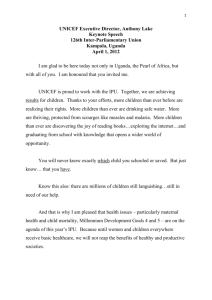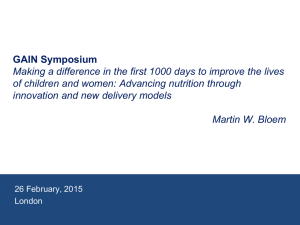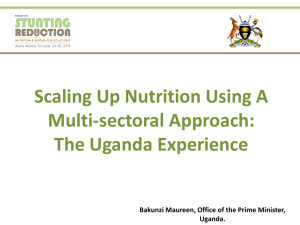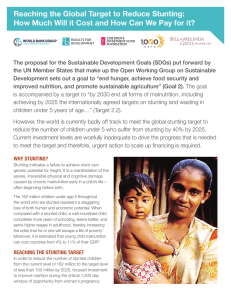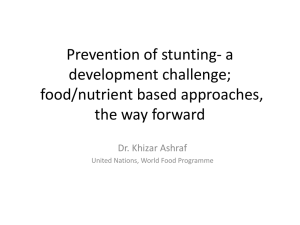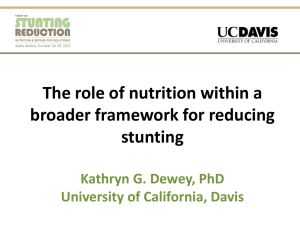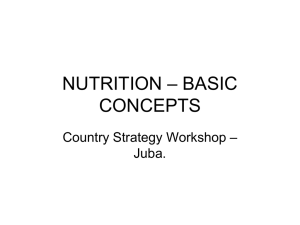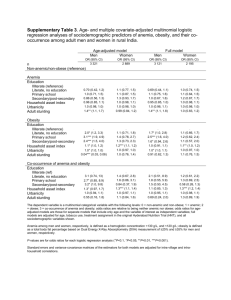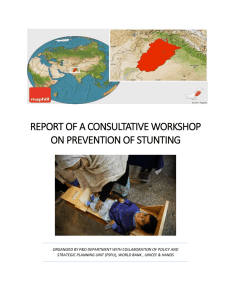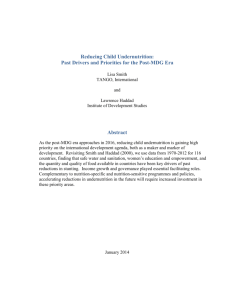Panel 2.3 How Did Maharashtra Cut Child Stunting?
advertisement
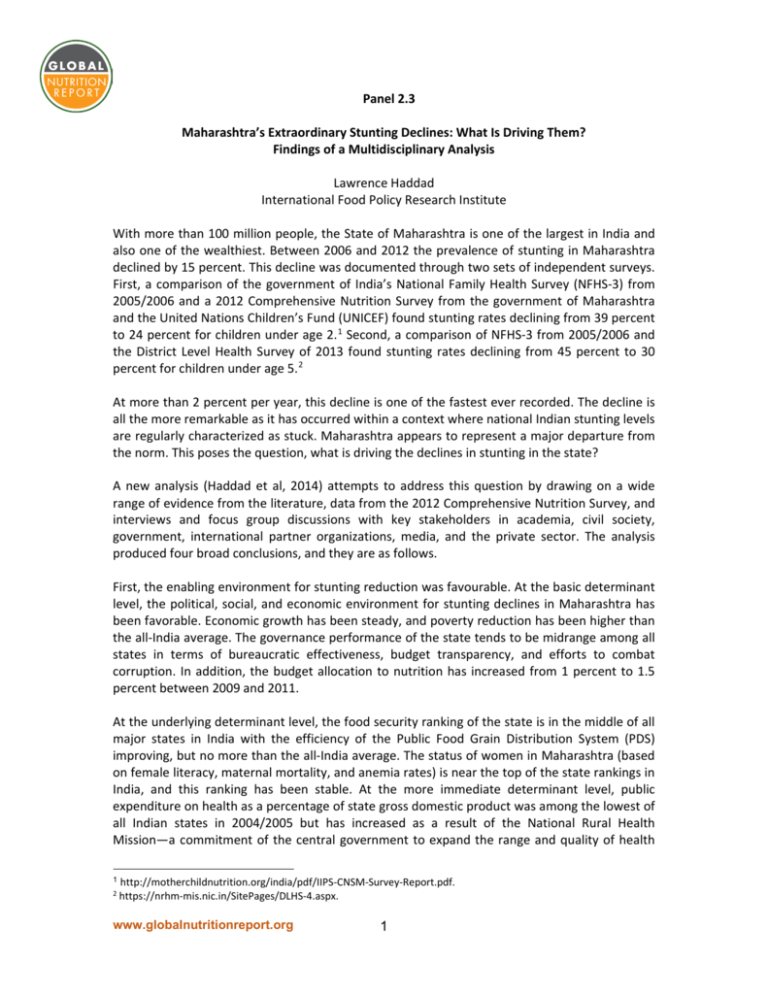
Panel 2.3 Maharashtra’s Extraordinary Stunting Declines: What Is Driving Them? Findings of a Multidisciplinary Analysis Lawrence Haddad International Food Policy Research Institute With more than 100 million people, the State of Maharashtra is one of the largest in India and also one of the wealthiest. Between 2006 and 2012 the prevalence of stunting in Maharashtra declined by 15 percent. This decline was documented through two sets of independent surveys. First, a comparison of the government of India’s National Family Health Survey (NFHS-3) from 2005/2006 and a 2012 Comprehensive Nutrition Survey from the government of Maharashtra and the United Nations Children’s Fund (UNICEF) found stunting rates declining from 39 percent to 24 percent for children under age 2. 1 Second, a comparison of NFHS-3 from 2005/2006 and the District Level Health Survey of 2013 found stunting rates declining from 45 percent to 30 percent for children under age 5. 2 At more than 2 percent per year, this decline is one of the fastest ever recorded. The decline is all the more remarkable as it has occurred within a context where national Indian stunting levels are regularly characterized as stuck. Maharashtra appears to represent a major departure from the norm. This poses the question, what is driving the declines in stunting in the state? A new analysis (Haddad et al, 2014) attempts to address this question by drawing on a wide range of evidence from the literature, data from the 2012 Comprehensive Nutrition Survey, and interviews and focus group discussions with key stakeholders in academia, civil society, government, international partner organizations, media, and the private sector. The analysis produced four broad conclusions, and they are as follows. First, the enabling environment for stunting reduction was favourable. At the basic determinant level, the political, social, and economic environment for stunting declines in Maharashtra has been favorable. Economic growth has been steady, and poverty reduction has been higher than the all-India average. The governance performance of the state tends to be midrange among all states in terms of bureaucratic effectiveness, budget transparency, and efforts to combat corruption. In addition, the budget allocation to nutrition has increased from 1 percent to 1.5 percent between 2009 and 2011. At the underlying determinant level, the food security ranking of the state is in the middle of all major states in India with the efficiency of the Public Food Grain Distribution System (PDS) improving, but no more than the all-India average. The status of women in Maharashtra (based on female literacy, maternal mortality, and anemia rates) is near the top of the state rankings in India, and this ranking has been stable. At the more immediate determinant level, public expenditure on health as a percentage of state gross domestic product was among the lowest of all Indian states in 2004/2005 but has increased as a result of the National Rural Health Mission—a commitment of the central government to expand the range and quality of health 1 2 http://motherchildnutrition.org/india/pdf/IIPS-CNSM-Survey-Report.pdf. https://nrhm-mis.nic.in/SitePages/DLHS-4.aspx. www.globalnutritionreport.org 1 services to rural areas. The performance of the major nutrition-related program, the Integrated Child Development Services (ICDS), was already among the best in India and has improved in terms of filling frontline health worker vacancies. Finally, the state’s own Nutrition Mission—a public declaration by the state government of its commitment to nutrition improvements— seems to have emerged organically and gained strength over time, serving as a model for other states and gaining support from UNICEF. The survey data confirm the broad-based nature of the declines in stunting (across all wealth rankings, in rural and urban areas, and for boys and girls), with large improvements in some of the stunting determinants (although not in access to improved drinking water). So the first key take-away message is that when most nutrition determinants are moving in the right direction—some in very modest ways—large changes in stunting rates can happen. Second, while the context is positive, it is far from perfect, and yet stunting has declined dramatically. For example, the water and sanitation environment remains relatively weak, and neither is it improving as quickly as in some other Indian states. Open defecation rates remain near 60 percent and the state remains near the all-India average for access to improved water sources. Agricultural growth is weak and highly variable, and the performance in filling the vacancies for ICDS supervisors lags far behind the ability of the state to recruit the frontline workers who are to be supervised. The second encouraging conclusion, then, is that stunting rates can decline rapidly in the absence of perfection. The third conclusion is that changes in stunting rates of this magnitude are driven by changes that can take more than a decade to be fully realized and scaled up. This is especially true if the aim is to break the intergenerational cycle of undernutrition and improve maternal and child nutrition sustainably. The journey to lower stunting rates in 2012 had its roots in the early years of the new millennium with the work of a number of dedicated bureaucrats, civil society activists, and members of the media who worked hard to frame the notion that a high level of undernutrition is not an acceptable norm. When all the elements came together—good economic performance, overall governance that is average for all-India (with a good and improving governance of ICDS), some strength in underlying determinants, health system improvements, and improvements in the commitment to nutrition spending and nutrition interventions—a threshold was crossed and stunting rates declined quickly. But behind the rapid decline was a decade of commitment from a wide range of actors. Finally, the Maharashtra experience shows that leadership matters. While the analysis found it difficult to conclude whether or not the stunting declines could have been achieved without the Nutrition Mission, the stakeholders interviewed said it was very helpful. Primarily it signaled commitment from the top, it served to recalibrate norms of what is acceptable, it served as a clarion call to help focus both new and existing domestic resources on malnutrition reduction, and it meant that successive chief ministers were prepared to be held accountable for the delivery of results. The mission also highlighted the importance of individual leadership, both in the civil service and then civil society (such as V. Ramini, the former head of the Nutrition Mission) and in government (such as the chief ministers). Overall the Maharashtra experience shows us that when leadership in government and civil society join forces within a supportive socioeconomic context, public action can reduce undernutrition—fast. www.globalnutritionreport.org 2 References Haddad, L., N. Nisbett, I. Barnett, and E. Valli. 2014. Maharashtra’s Child Stunting Declines: What Is Driving Them? Findings of a Multidisciplinary Analysis. Brighton, UK: Institute of Development Studies. www.globalnutritionreport.org 3

